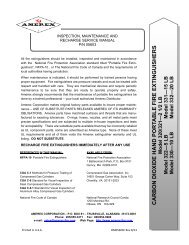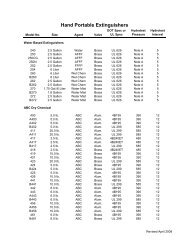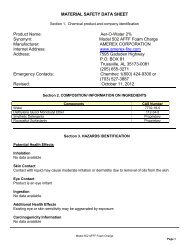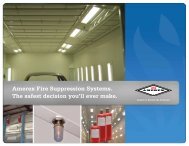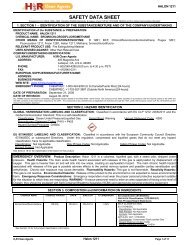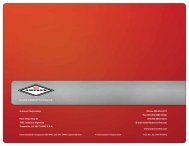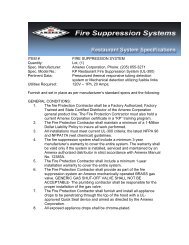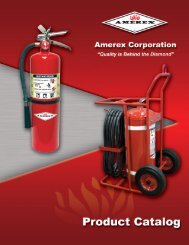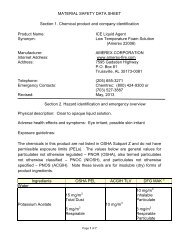Manual for 125-150 lb. cartridge operated - Amerex Corporation
Manual for 125-150 lb. cartridge operated - Amerex Corporation
Manual for 125-150 lb. cartridge operated - Amerex Corporation
Create successful ePaper yourself
Turn your PDF publications into a flip-book with our unique Google optimized e-Paper software.
13. Disconnect the high pressure hose from the argon cylinder valve. Securely install the service kit<br />
Argon/Nitrogen Cylinder Pressure Check Gauge Assembly to the nitrogen cylinder valve outlet<br />
and verify the indicated cylinder gauge pressure. Argon pressure should con<strong>for</strong>m to the<br />
temperature correction chart provided in the Troubleshooting section of this manual. Close the<br />
nitrogen cylinder valve and disconnect the Pressure Check Gauge Assembly.<br />
WARNING: IF THE NITROGEN CYLINDER VALVE HAS A "T" HANDLE QUICK OPENING<br />
OR A HANDWHEEL QUICK OPENING TRIP RELEASE, THE SAFETY VENT PLUG<br />
SHIPPED WITH THE EXTINGUISHER, OR THE TEST KIT SAFETY VENT PLUG MUST BE<br />
INSTALLED TO PROTECT SERVICE PERSONNEL FROM A HIGH VELOCITY DISCHARGE<br />
IN CASE THE LEVER IS ACCIDENTALLY OPENED.<br />
14. Install a new <strong>Amerex</strong> Moisture Seal per instructions in the package. Securely connect the<br />
discharge hose to the extinguisher. When assembling the hose to the agent cylinder or<br />
nozzle to the hose, tighten the coupling ¼ turn after contacting the hose gasket.<br />
15. Coil the hose on to the extinguisher hose rack using the Reverse Loop Procedure (see<br />
instructions in this manual). Install shut-off nozzle (and/or extension wand) with the lever in the<br />
Closed (<strong>for</strong>ward) position into the nozzle mount.<br />
16. Remove the safety vent plug from the argon cylinder. Reconnect the high pressure hose<br />
securely to the nitrogen cylinder valve. Wipe the extinguisher clean. Record service data on<br />
the inspection tag according to NFPA-10 requirements and attach to extinguisher. Return<br />
extinguisher to its proper location.<br />
RECHARGE<br />
NFPA 10 – Recharging is the replacement of the extinguishing agent and also includes the<br />
expellant <strong>for</strong> this type of extinguisher.<br />
RECHARGING PROCEDURE<br />
WARNING: BEFORE ATTEMPTING TO RECHARGE, BE SURE THIS EXTINGUISHER IS<br />
COMPLETELY DEPRESSURIZED. THERE IS A CHECK VALVE IN THE SYSTEM<br />
WHICH PREVENTS ARGON PRESSURE FROM ESCAPING FROM THE AGENT<br />
CYLINDER WHEN THE ARGON HOSE IS DISCONNECTED. THE AGENT<br />
CYLINDER MAY BE PRESSURIZED EVEN THOUGH NO PRESSURE ESCAPES<br />
FROM THE CYLINDER ARGON CONNECTION.<br />
NOTE: Proper procedure <strong>for</strong> recharging any dry chemical extinguisher includes the use of a<br />
“closed recovery system (NFPA-10). The Getz Model SV1 400 VACU-FILL SYSTEM is<br />
ideal <strong>for</strong> this application – it provides <strong>for</strong> the recovery of the remaining agent by direct<br />
discharge into the system, trapping the “fines” while allowing the nitrogen to escape and<br />
provides a more accurate fill of the extinguisher.<br />
IF A “CLOSED RECOVERY SYSTEM” IS NOT AVAILABLE PROCEED AS<br />
FOLLOWS:<br />
1. To depressurize:<br />
a. Close the argon cylinder valve.<br />
8



